“The Baguales, a distinguished breed of wild horses, grace the sweeping grasslands and dense forests of Patagonia, traversing the territories of Argentina and Chile with remarkable adaptability.
Characterized by their sturdy physique, these equine marvels exhibit a profound resilience, enabling them to endure the widely fluctuating climatic conditions of this region. Their presence in these lands stands as a testament to the enduring spirit and robustness of nature’s creations.”
History:
The Baguales horse’s history dates back to 16th-century South America with the arrival of Spanish conquistadors who brought various breeds from Iberian-influenced horses with them to South America. Over time, some domesticated horses escaped or were abandoned – many found shelter in Patagonia – which spans across both Argentina and Chile.
Once free, these horses underwent an astounding transformation. Without human influence and breeding control, natural selection took its place and Patagonia’s harsh landscapes with its rugged terrain, dense forests, and extreme climate molded them into breeds uniquely adapted to survive under these harsh conditions.
Thus emerged a distinct breed known as Baguales that proved resilient enough to cope with such environments successfully.
Baguales horses have recently encountered many threats, from expanding human settlements, changing land use, and modern livestock farming, all posing threats to their habitat and way of life.
Conservation efforts are vital to ensuring their survival; such efforts include ecological impact studies, initiatives preserving natural habitat, and programs designed to ensure a balance between wild horses and local ecosystem needs.


Physical Characteristics:
The Baguales horse, well known for its untamable nature and wild temperament, possesses several specific physical traits that enable it to thrive in Patagonia – an area spanning both Argentina and Chile – by adapting and flourishing within its rugged terrains. Some key aspects of their physical traits:
Baguales horses are well known for their sturdy and muscular physique, an adaptation to Patagonia’s challenging environments where only strong and resilient animals thrive.
Size: These horses typically possess medium body sizes with strong bones. Their dimensions match up well to available resources and the terrain they occupy, providing efficient movement and endurance.
Coat: A Baguales horse’s coat often ranges in color between bay, black and chestnut hues – often thicker compared to domesticated horses – providing essential insulation against unpredictable climate conditions of its habitat.
Mane and Tail: They feature thick, often-tangled manes and tails which provide protection from elements such as direct sunlight, wind gusts, and cold temperatures.
Hooves: Baguales horses boast particularly hard and well-formed hooves as an innate adaptation for traversing Patagonia’s varied and often challenging terrain, from rugged outcrops to dense forests.
Endurance and Agility: These horses are known for their extreme endurance and agility – qualities essential to survival in the wild. Able to travel long distances searching for food and water sources while adeptly navigating diverse environments within their ecosystem, endurance-and-agile horses provide essential survival services in their environment.
Adaptive Features: Horses have evolved adaptations over generations that help them thrive in their environment, such as enhanced awareness and an instinctual drive to protect themselves.
Cultural Significance:
To the local cultures, Baguales horses are more than just wildlife; they are symbols of freedom and resilience.
Indigenous stories and local folklore often portray these horses as emblematic of the untamed spirit of the land. They hold a special place in the hearts of the people, representing a connection to a wilder, untamed past.


